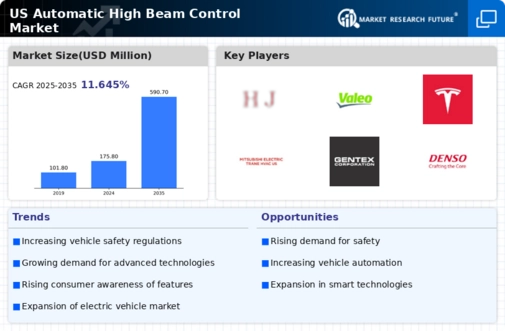Rising Nighttime Driving Incidents
The automatic high-beam-control market is influenced by the rising number of nighttime driving incidents in the US. Statistics reveal that nearly 50% of all fatal accidents occur during nighttime hours, highlighting the need for improved visibility. As consumers become more aware of these risks, the demand for vehicles equipped with automatic high-beam systems is likely to increase. This heightened awareness may lead to a projected market growth of approximately 15% annually over the next five years. Consequently, manufacturers are expected to prioritize the integration of these systems into their vehicle offerings, further stimulating the automatic high-beam-control market.
Regulatory Support for Safety Features
The automatic high-beam-control market benefits from increasing regulatory support aimed at enhancing vehicle safety. In the US, the National Highway Traffic Safety Administration (NHTSA) has been advocating for advanced driver-assistance systems (ADAS) that include automatic high-beam controls. This regulatory push is likely to drive adoption rates, as manufacturers seek compliance with safety standards. As of 2025, it is estimated that vehicles equipped with such safety features could account for over 30% of new car sales in the US. This trend indicates a growing recognition of the importance of automatic high-beam-control systems in reducing nighttime accidents, thereby propelling the market forward.
Technological Integration with Smart Systems
The automatic high-beam-control market is experiencing growth due to the integration of smart technologies in vehicles. Advanced sensors and cameras are now being utilized to enhance the functionality of automatic high-beam systems, allowing for real-time adjustments based on traffic conditions. This technological evolution is expected to attract tech-savvy consumers who prioritize safety and convenience. By 2026, it is anticipated that the market for smart vehicle technologies will reach $200 billion in the US, with automatic high-beam-control systems playing a crucial role in this expansion. The synergy between smart systems and automatic high-beam controls is likely to redefine consumer expectations in the automotive sector.
Increased Investment in Automotive Innovation
the automatic high-beam-control market is set to grow due to increased investment in automotive innovation. Major automotive manufacturers are allocating substantial resources towards research and development of advanced lighting systems. This investment is driven by the need to meet evolving consumer expectations and regulatory requirements. In 2025, it is projected that R&D spending in the automotive sector will exceed $100 billion in the US, with a significant portion directed towards enhancing safety features like automatic high-beam controls. This focus on innovation is likely to result in more sophisticated and reliable systems, thereby expanding the automatic high-beam-control market and attracting a broader consumer base.
Consumer Preference for Enhanced Safety Features
The automatic high-beam-control market is significantly driven by consumer preference for enhanced safety features in vehicles. As safety becomes a paramount concern for buyers, manufacturers are increasingly incorporating advanced lighting technologies into their designs. Surveys indicate that over 70% of consumers consider safety features, including automatic high-beam controls, as a critical factor when purchasing a vehicle. This trend suggests a shift in consumer behavior, where the demand for vehicles equipped with such systems is likely to rise. Consequently, the automatic high-beam-control market may witness a compound annual growth rate (CAGR) of around 12% over the next few years, reflecting the growing emphasis on safety in automotive purchases.






















Leave a Comment